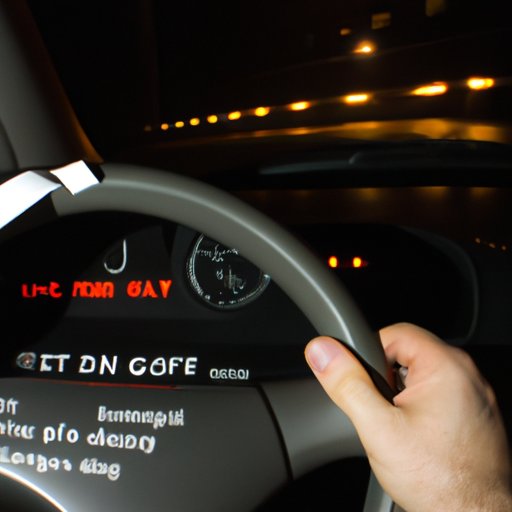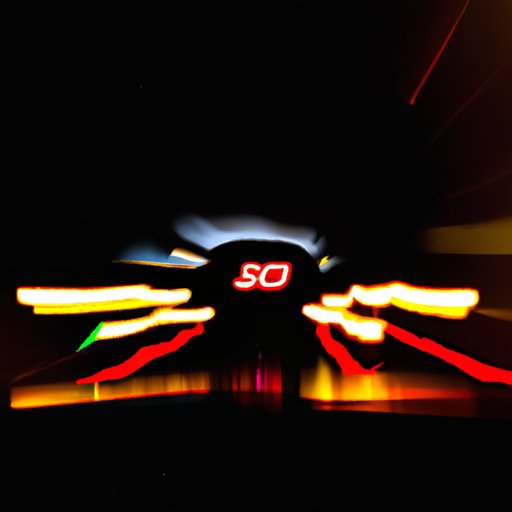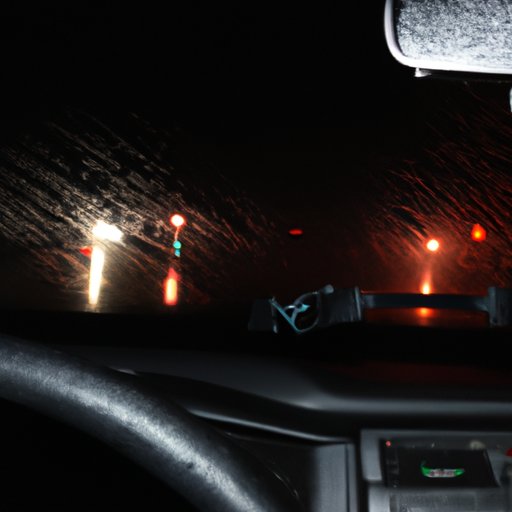Introduction
Driving at night can be a dangerous and stressful experience. Poor visibility, unexpected hazards, and distracted drivers all increase the risk of getting into an accident. According to a study from the National Highway Traffic Safety Administration, nearly half of all fatal car crashes occur between the hours of 6 pm and 6 am. To ensure your safety on the road, it is important to know the risks associated with driving at night and understand how to prepare for and navigate dark roads.
Tips for Safely Navigating Dark Roads
When driving at night, there are certain precautions you should take to make sure you reach your destination safely. Here are some tips to keep in mind:
Use High Beam Headlights
Using your high beams when driving at night will help you see further down the road and give you more time to react to any potential hazards. However, it is important to be aware of other drivers around you and switch to low beams if you are approaching another vehicle or when you are within 500 feet of oncoming traffic.
Reduce Speed
It is always important to obey the posted speed limit and drive at a safe speed, but this is especially true when driving at night. When visibility is limited, you need to give yourself extra time to react to any obstacles in the road. According to a study conducted by the University of Michigan Transportation Research Institute, reducing your speed by just five miles per hour can significantly reduce the risk of an accident.
Increase Following Distance
To give yourself enough time to react to any sudden stops or turns, make sure to increase your following distance when driving at night. The rule of thumb is to maintain a three-second gap between you and the vehicle in front of you. This will allow you to have plenty of space to stop if necessary.
Avoid Distractions
Distracted driving is one of the leading causes of car accidents, and it becomes even more dangerous when driving at night. To ensure your safety on the road, it is important to avoid all distractions while driving, including talking on the phone, texting, eating, and adjusting the radio.

How to Prepare for Driving at Night
In addition to knowing how to safely navigate dark roads, it is also important to be prepared before you get behind the wheel. Here are some tips for prepping your vehicle for nighttime driving:
Check Vehicle Lights and Tires
Before you set off on your journey, make sure all of your vehicle’s lights are working properly. This includes headlights, taillights, brake lights, turn signals, and fog lights. It is also important to check your tires to make sure they are properly inflated and have enough tread to provide good traction.
Have a Plan for Emergencies
In the event of a breakdown or flat tire, it is important to have a plan for what to do. Make sure you have a spare tire, jumper cables, and a flashlight in your vehicle in case of emergencies. Additionally, it is a good idea to program your phone with emergency numbers and the number of a roadside assistance service.
Stay Alert and Refreshed
Drowsy driving can be just as dangerous as drunk driving, so it is important to make sure you are alert and well-rested before driving at night. If you find yourself feeling tired or drowsy, pull over to a safe spot and take a short nap or walk around to wake yourself up.
What to Look Out for When Driving at Night
When driving at night, there are certain hazards you should be aware of to ensure your safety on the road. Here are some things to watch out for:
Animals on the Road
Animals such as deer, skunks, and raccoons are often active at night and can suddenly appear in the middle of the road. To avoid hitting an animal, it is important to pay attention to your surroundings and use your high beams to help you spot any animals in the area.
Poor Visibility
Poor visibility is one of the biggest challenges when driving at night. Fog, rain, and snow can all make it difficult to see the road ahead, so it is important to slow down and increase your following distance.
Drunk Drivers
Unfortunately, drunk drivers are more common at night than during the day. To stay safe on the road, be aware of drivers who are swerving, speeding, or driving erratically and keep your distance.

Tips for Maintaining Visibility When Driving at Night
Maintaining good visibility is essential when driving at night, so it is important to take steps to ensure your windshield and headlights are in good condition. Here are some tips to keep in mind:
Clean Windshield Wipers
Make sure your windshield wipers are clean and in good condition before setting off on your journey. Dirty wipers can cause streaks that can obstruct your vision in wet weather.
Keep Headlights Adjusted
It is important to keep your headlights adjusted correctly so you can see the road clearly. To do this, park your vehicle 25 feet away from a wall and adjust the headlights until they are parallel to the ground.
Adjust Mirrors
Properly adjusted side mirrors can help you stay aware of your surroundings and anticipate any potential hazards. To adjust your mirrors, sit in the driver’s seat and adjust the side mirrors until you can just barely see the sides of your vehicle.

Strategies for Reducing Stress While Driving at Night
Driving at night can be stressful, so it is important to have strategies in place to help you stay calm and focused on the road. Here are some tips to keep in mind:
Listen to Music
Listening to music can help you relax and stay focused on the task at hand. Make sure to choose calming music and keep the volume at a reasonable level so you can still hear the sounds of the road.
Don’t Rush
When driving at night, it is important to give yourself plenty of time to reach your destination. Don’t rush and take your time navigating dark roads so you can stay relaxed and avoid making any costly mistakes.
Take Breaks
If you find yourself feeling stressed, pull over to a safe spot and take a few minutes to stretch your legs and clear your head. Taking a break can help you stay alert and refreshed so you can continue your journey safely.
What You Need to Know About Driving in Low-Light Conditions
Driving in low-light conditions such as dusk or dawn can be tricky, so it is important to know how to stay safe on the road. Here are some tips to keep in mind:
Wear Prescription Glasses
If you wear prescription glasses, it is important to make sure they are up to date and free from scratches. This will help you see better in low-light conditions and give you more time to react to any potential hazards.
Slow Down
When driving in low-light conditions, it is important to slow down and give yourself extra time to react to any obstacles in the road. According to a study conducted by the National Institutes of Health, driving slower in low-light conditions can reduce the risk of a crash by up to 59%.
Use Caution When Passing
When passing another vehicle in low-light conditions, it is important to use caution and make sure you have enough time to merge back into your lane. To do this, increase your following distance and make sure you can see the entire vehicle in your rearview mirror before merging back in.
Conclusion
Driving at night can be a scary and stressful experience, but knowing how to navigate dark roads safely and being prepared for any potential hazards can help you stay safe on the road. By following the tips outlined in this article, you can reduce your risk of getting into an accident and arrive at your destination safely.
(Note: Is this article not meeting your expectations? Do you have knowledge or insights to share? Unlock new opportunities and expand your reach by joining our authors team. Click Registration to join us and share your expertise with our readers.)
